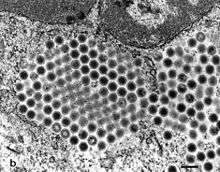Iridovirus
| Iridovirus | |
|---|---|
 | |
| Virus classification | |
| Group: | Group I (dsDNA) |
| Family: | Iridoviridae |
| Genus: | Iridovirus |
| Type Species | |
| |
Iridovirus is a genus of viruses, in the family Iridoviridae. Insects serve as natural hosts. There are currently only two species in this genus including the type species Invertebrate iridescent virus 6. Diseases associated with this genus include: in mosquitoes, IIV-6 usually causes covert (inapparent) infection that reduces fitness.[1][2]
Taxonomy
Group: dsDNA
- Family: Iridoviridae
- Genus: Iridovirus
- Invertebrate iridescent virus 1
- Invertebrate iridescent virus 6
Structure
Viruses in Iridovirus are enveloped, with icosahedral and Polyhedral geometries, and T=147 symmetry. The diameter is around 185 nm. Genomes are circular, around 213kb in length. The genome codes for 211 proteins.[1]
| Genus | Structure | Symmetry | Capsid | Genomic Arrangement | Genomic Segmentation |
|---|---|---|---|---|---|
| Iridovirus | Polyhedral | T=147 | Linear | Monopartite |
Life Cycle
Viral replication is nucleo-cytoplasmic. Entry into the host cell is achieved by attachment of the viral proteins to host receptors, which mediates endocytosis. Replication follows the DNA strand displacement model. DNA-templated transcription is the method of transcription. Insects serve as the natural host.[1]
| Genus | Host Details | Tissue Tropism | Entry Details | Release Details | Replication Site | Assembly Site | Transmission |
|---|---|---|---|---|---|---|---|
| Iridovirus | Insects | None | Cell receptor endocytosis | Lysis; budding | Nucleus | Cytoplasm | Contact |
References
- 1 2 3 "Viral Zone". ExPASy. Retrieved 15 June 2015.
- 1 2 ICTV. "Virus Taxonomy: 2014 Release". Retrieved 15 June 2015.